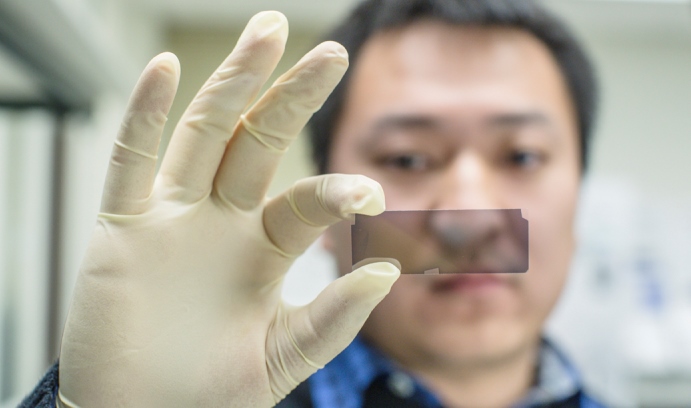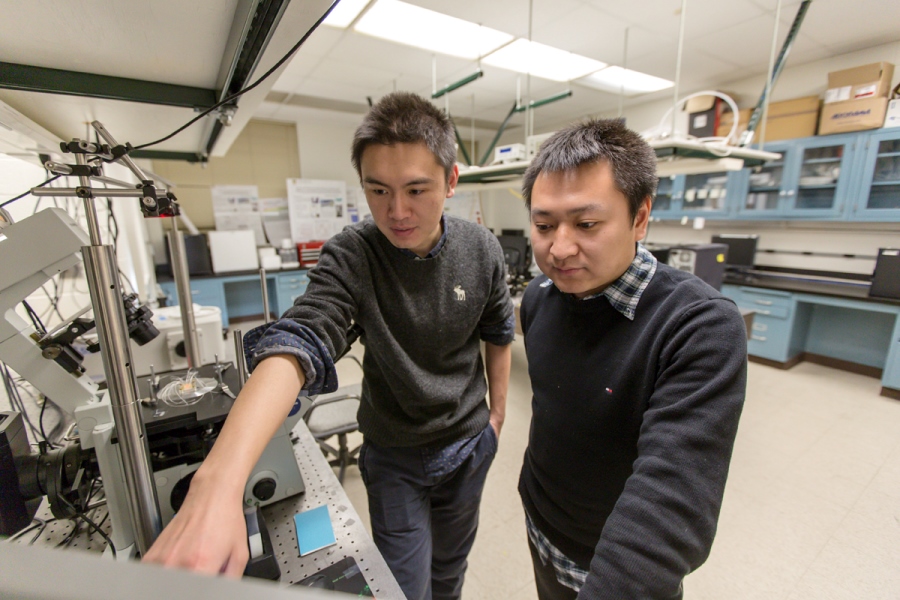Fine-tuning a rainbow of colors at the nanoscale

Beibei Zeng’s group more than doubled the transmission efficiency of plasmonic color filters by fabricating the filters on an ultrathin, 30 nanometer-thick silver film patterned with one-dimensional nanogratings.
TVs, image sensors, iPads, digital cameras and other modern devices use filters to display the breadth of colors available in the visible portion of the electromagnetic spectrum.
Conventional color filters are typically made of organic dyes or chemicals, but they can be damaged by heat and ultraviolet radiation (UVR), and they are complicated and costly to fabricate, especially for miniature cameras and imagers.
For these reasons, says Beibei Zeng, engineers are turning to plasmonic color filters (PCFs), which are based on surface plasmons, or the collective oscillation of electrons at metal/dielectric interfaces. These filters are made by fabricating, on a thin metal film, arrays of holes with diameters of 100 nanometers or less (1 nm equals one billionth of a meter).
By varying the geometry of these nanoholes—their diameter, shape, periodicity and pattern—it is possible to control the colors that are transmitted and to create transmit a broad spectrum of colors for imaging applications.
“PCFs have many advantages,” says Zeng, who is a Ph.D. candidate in electrical engineering. “They are simple to make and they are easily tuned over a wide range of colors. Also, they are very stable and they are not vulnerable to damage from heat, humidity or UVR.”
In their current state of development, however, PCFs have a major disadvantage: the efficiency with which they transmit light is only about 30 percent—less than half the rate of 80 percent transmission efficiency achieved by conventional color filters.
Zeng leads a Lehigh research team that has developed a new PCF scheme that achieves a transmission efficiency of 60 to 70 percent. The method relies on a subtractive filtering approach that differs fundamentally from the additive filters typically employed in PCFs.
The group reported its results recently in a paper titled “Ultrathin Nanostructured Metals for Highly Transmissive Plasmonic Subtractive Color Filters,” which was published by Scientific Reports, a publication of the Nature group. The paper was written by Zeng; Filbert J. Bartoli, department chair and professor of electrical and computer engineering and Zeng’s adviser; and Yongkang Gao, who recently completed his Ph.D. in electrical engineering at Lehigh.
Capitalizing on advances in nanofabrication
Subtractive color filters (SCFs) are widely used in image sensors, says Zeng. They have advantages over additive color filters (ACFs) in color signal strength and light transmission, but researchers have not yet been able to produce high-performance plasmonic SCFs.
Zeng’s group demonstrated it was able to increase the efficiency of plasmonic SCFs in a study that combined theoretical design, simulation, fabrication using focused ion beam lithography, and experimental demonstration.
“We are fortunate at Lehigh to have broad interdisciplinary research capabilities,” says Zeng. “After we do theoretical work, we fabricate devices and then conduct experiments that tell us whether the devices will work or not.”
The theoretical work and simulation helped his group to clarify the underlying physics of what Zeng calls the “counter-intuitive” phenomenon of extraordinary low transmission (ELT) in ultrathin nanopatterned metal films. Reported relatively recently, ELT is considered by researchers to hold promise for the development of new polarization filters.
Zeng’s group explored ELT on a 30 nm-thick silver film patterned with one-dimensional nanogratings and achieved subtractive color filtering with a transmission efficiency of up to 70 percent. They were able to generate cyan, magenta and yellow colors by removing their complementary components (red, blue and green) from the visible portion of the electromagnetic spectrum.
Recent advances in nanofabrication, says Zeng, enabled his group to work with the ultrathin films, which are nearly an order of magnitude thinner than the 200 nm-thick films onto which additive PCFs are typically etched. Patterning the ultrathin silver metal films has caused critical changes in their physical and optical properties and enabled the group to significantly increase the transmission efficiency of plasmonic SCFs.
“The relative thinness of our filters causes a coupling in the electromagnetic resonances at the top and the bottom of the metal surface,” says Zeng. “This does not occur with thicker metal films. Without this coupling, a transmission peak occurs; with it, the peak becomes a valley and causes a transmission dip.
“We can control this transmission dip by tuning the dimensions of the nanostructures on the metal film. Just a few years ago, we could not fabricate such thin structures. Now we can fabricate nanostructures systematically and achieve fine control of the colors transmitted through the nanostructured films.”
In addition to achieving transmission efficiency approaching that of commercial image sensors, the plasmonic SCFs boost spatial resolution by yielding ultracompact pixel sizes, which are required in high-definition TVs and in the latest smartphones. This occurs because of the short-range interactions of the surface plasmon polaritons (SPPs) between neighboring nanostructures at ELT resonances.
This polarization-dependence color filtering, the group writes in Scientific Reports, gives 1-D plasmonic SCFs the potential to “function as transparent windows under transverse-electric polarization” and makes them “highly attractive” for next-generation transparent displays.
“These unique polarization-dependent features allow the same structures to function either as color filters or highly-transparent windows under different polarizations, opening an avenue towards high-definition transparent displays.”
“Current transparent displays are currently limited by their low spatial resolution and poor color gamut,” says Zeng. “Our work with plasmonic SCFs has solved both problems. We can get whatever color we want and with very high resolution because of our ultracompact pixel sizes.”
The group’s paper has been downloaded more than 1,300 times since it was published in October, and it was recently cited in an article published by Nano Letters.
Photos by Christa Neu
Conventional color filters are typically made of organic dyes or chemicals, but they can be damaged by heat and ultraviolet radiation (UVR), and they are complicated and costly to fabricate, especially for miniature cameras and imagers.
For these reasons, says Beibei Zeng, engineers are turning to plasmonic color filters (PCFs), which are based on surface plasmons, or the collective oscillation of electrons at metal/dielectric interfaces. These filters are made by fabricating, on a thin metal film, arrays of holes with diameters of 100 nanometers or less (1 nm equals one billionth of a meter).
By varying the geometry of these nanoholes—their diameter, shape, periodicity and pattern—it is possible to control the colors that are transmitted and to create transmit a broad spectrum of colors for imaging applications.
“PCFs have many advantages,” says Zeng, who is a Ph.D. candidate in electrical engineering. “They are simple to make and they are easily tuned over a wide range of colors. Also, they are very stable and they are not vulnerable to damage from heat, humidity or UVR.”
In their current state of development, however, PCFs have a major disadvantage: the efficiency with which they transmit light is only about 30 percent—less than half the rate of 80 percent transmission efficiency achieved by conventional color filters.
Zeng leads a Lehigh research team that has developed a new PCF scheme that achieves a transmission efficiency of 60 to 70 percent. The method relies on a subtractive filtering approach that differs fundamentally from the additive filters typically employed in PCFs.
The group reported its results recently in a paper titled “Ultrathin Nanostructured Metals for Highly Transmissive Plasmonic Subtractive Color Filters,” which was published by Scientific Reports, a publication of the Nature group. The paper was written by Zeng; Filbert J. Bartoli, department chair and professor of electrical and computer engineering and Zeng’s adviser; and Yongkang Gao, who recently completed his Ph.D. in electrical engineering at Lehigh.
Capitalizing on advances in nanofabrication
Subtractive color filters (SCFs) are widely used in image sensors, says Zeng. They have advantages over additive color filters (ACFs) in color signal strength and light transmission, but researchers have not yet been able to produce high-performance plasmonic SCFs.
Zeng’s group demonstrated it was able to increase the efficiency of plasmonic SCFs in a study that combined theoretical design, simulation, fabrication using focused ion beam lithography, and experimental demonstration.
“We are fortunate at Lehigh to have broad interdisciplinary research capabilities,” says Zeng. “After we do theoretical work, we fabricate devices and then conduct experiments that tell us whether the devices will work or not.”
The theoretical work and simulation helped his group to clarify the underlying physics of what Zeng calls the “counter-intuitive” phenomenon of extraordinary low transmission (ELT) in ultrathin nanopatterned metal films. Reported relatively recently, ELT is considered by researchers to hold promise for the development of new polarization filters.
Zeng’s group explored ELT on a 30 nm-thick silver film patterned with one-dimensional nanogratings and achieved subtractive color filtering with a transmission efficiency of up to 70 percent. They were able to generate cyan, magenta and yellow colors by removing their complementary components (red, blue and green) from the visible portion of the electromagnetic spectrum.
Recent advances in nanofabrication, says Zeng, enabled his group to work with the ultrathin films, which are nearly an order of magnitude thinner than the 200 nm-thick films onto which additive PCFs are typically etched. Patterning the ultrathin silver metal films has caused critical changes in their physical and optical properties and enabled the group to significantly increase the transmission efficiency of plasmonic SCFs.
“The relative thinness of our filters causes a coupling in the electromagnetic resonances at the top and the bottom of the metal surface,” says Zeng. “This does not occur with thicker metal films. Without this coupling, a transmission peak occurs; with it, the peak becomes a valley and causes a transmission dip.
“We can control this transmission dip by tuning the dimensions of the nanostructures on the metal film. Just a few years ago, we could not fabricate such thin structures. Now we can fabricate nanostructures systematically and achieve fine control of the colors transmitted through the nanostructured films.”
In addition to achieving transmission efficiency approaching that of commercial image sensors, the plasmonic SCFs boost spatial resolution by yielding ultracompact pixel sizes, which are required in high-definition TVs and in the latest smartphones. This occurs because of the short-range interactions of the surface plasmon polaritons (SPPs) between neighboring nanostructures at ELT resonances.
This polarization-dependence color filtering, the group writes in Scientific Reports, gives 1-D plasmonic SCFs the potential to “function as transparent windows under transverse-electric polarization” and makes them “highly attractive” for next-generation transparent displays.
“These unique polarization-dependent features allow the same structures to function either as color filters or highly-transparent windows under different polarizations, opening an avenue towards high-definition transparent displays.”
“Current transparent displays are currently limited by their low spatial resolution and poor color gamut,” says Zeng. “Our work with plasmonic SCFs has solved both problems. We can get whatever color we want and with very high resolution because of our ultracompact pixel sizes.”
The group’s paper has been downloaded more than 1,300 times since it was published in October, and it was recently cited in an article published by Nano Letters.
Photos by Christa Neu
Posted on:
Monday, February 10, 2014


